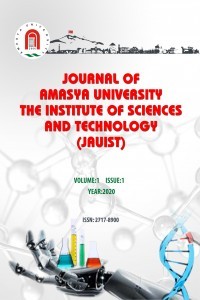APPLICATION OF ASYMMETRICAL ZINC PHTHALOCYANINES: ORGANIC FIELD EFFECT TRANSISTORS
APPLICATION OF ASYMMETRICAL ZINC PHTHALOCYANINES: ORGANIC FIELD EFFECT TRANSISTORS
Phthalocyanine, thin film ambipolar, OFET, carboxylic acid,
___
- 1. Dong S., Tian H., Huang L., Zhang J., Yan D., Geng Y., & Wang F. (2011). Non-Peripheral Tetrahexyl-Substituted Vanadyl Phthalocyanines with Intermolecular Cofacial π-π Stacking for Solution-Processed Organic Field-Effect Transistors. Advanced Materials, 23(25): 2850–2854.
- 2. Chaure N. B., Cammidge A. N., Chambrier I., Cook M. J., Ray A. K. (2015). A Tetrabenzotriazaporphyrin Based Organic Thin Film Transistor: Comparison with a Device of the Phthalocyanine Analogue. ECS Journal of Solid-State Science and Technology, 4(4): P3086–P3090.
- 3. Sirringhaus H. (2005). Device physics of solution‐processed organic field‐effect transistors. Advanced Materials, 17(20), 2411-2425.
- 4. Lever ABP., Leznoff CC. (1996). Phthalocyanine: properties and applications. Advanced Materials, Vol. 4 p.536.
- 5. Bottari G., Torre G. de la, Guldi, D.M., Torres T. (2010). Covalent and noncovalent phthalocyanine− carbon nanostructure systems: synthesis, photoinduced electron transfer, and application to molecular photovoltaics. Chemical Reviews, 110, 6768–6816.
- 6. Canımkurbey B., Taşkan M. C., Demir S., Duygulu, E., Atilla D., Yuksel F. (2020). Synthesis, and Investigation of Electrical Properties of Novel Liquid-Crystal Phthalocyanines bearing triple branched alkylthia chains. New Journal of Chemistry, 44, 7424-7435.
- 7. Warner M., Din S., Tupitsyn I.S., Morley G.W., Stoneham A.M., Bahçıvan J.A., Wu Z., Fisher A.J., Heutz S., Kay CW., Aeppli G. (2013). Potential for spin-based information processing in a thin-film molecular semiconductor. Nature, 503, 504-508.
- 8. Forrest S.R. (2004). The path to ubiquitous and low-cost organic electronic appliances on plastic. Nature, 428,9.
- 9. Scheinert S,. Paasch G,. Hörselmann I., Herasimovich A. (2010). Low-cost submicrometer organic fieled effect transistors. Advances in Polymer Science, 223,155.
- 10. Gürol İ., Ahsen V., and Bekaroǧlu Ö. (1994). Synthesis of tetraalkylthio-substituted phthalocyanines and their complexation with Ag I and Pd II. J. Chem. Soc., Dalt. Trans., 0, 497–500.
- 11. Canlica M., Nyokong T. (2011). Synthesis and photophysical properties of metal free, titanium, magnesium and zinc phthalocyanines substituted with a single carboxyl and hexylthio groups. Polyhedron, 30, 1975–1981.
- 12. Tunç G., Güzel E., Şişman İ., Ahsen V., Cardenas-J. G. (2019). Effect of new asymmetrical Zn(ii) phthalocyanines on the photovoltaic performance of a dye-sensitized solar cell. New J. Chem., 43, 14390–14401.
- 13. Tunç G., Albakour M., Ahsen V., Gürek AG. (2019). Peripherally carboxylic acid substituted asymmetric zinc(II) phthalocyanines: Synthesis and photophysicochemical properties. J. Porphyrins and Phthalocyanines, 23, 1355-1364.
- 14. L. Sun. (2015). Effect of relative nanohole position on colour purity of ultrathin plasmonic subtractive colour filters. Nanotechnology, 26, 30.
- ISSN: 2717-8900
- Yayın Aralığı: Yılda 2 Sayı
- Başlangıç: 2020
- Yayıncı: Amasya Üniversitesi
APPLICATION OF ASYMMETRICAL ZINC PHTHALOCYANINES: ORGANIC FIELD EFFECT TRANSISTORS
Gülenay TUNÇ, Betül CANIMKURBEY, Ayşe GÜL GUREK
A SPECTROSCOPIC INVESTIGATION OF ORPIMENT (YELLOW ARSENIC) USED AS A DEPILATORY
BIOACTIVITIES OF ISOLATED PHYTOCHEMICAL CONSTITUENTS AND EXTRACTS OF Crateva adansonii DC.
Vinujan SHANMUGALİNGAM, Saravanan VİVEKANANDARAJAH SATHASİVAMPİLLAİ, Pholtan Rajeev SEBASTİAN
ACHROMATIC COLORING OF QUADRILATERAL SNAKES
